On a daily basis, we are faced with the challenge of problem solving. Especially when designing new products or services, complex activities are triggered in our brains trying to elaborate the best solution.
The path to understanding these processes in detail paves the ground for supporting these problem solving issues by Artificial intelligence and to the idea of how an AI can take over the task and relief us from tasks like managing knowledge and documenting.
But first things first – how does it work when we address problems?
First, there was a problem to address which then leads to a solution.
Wait, one solution? Not at all.
For every problem, there can be several solutions. Each of which has a certain probability of being the one to choose from. The probability is defined by explicit and implicit knowledge we use to address the problem space and transform it into the correct solution:
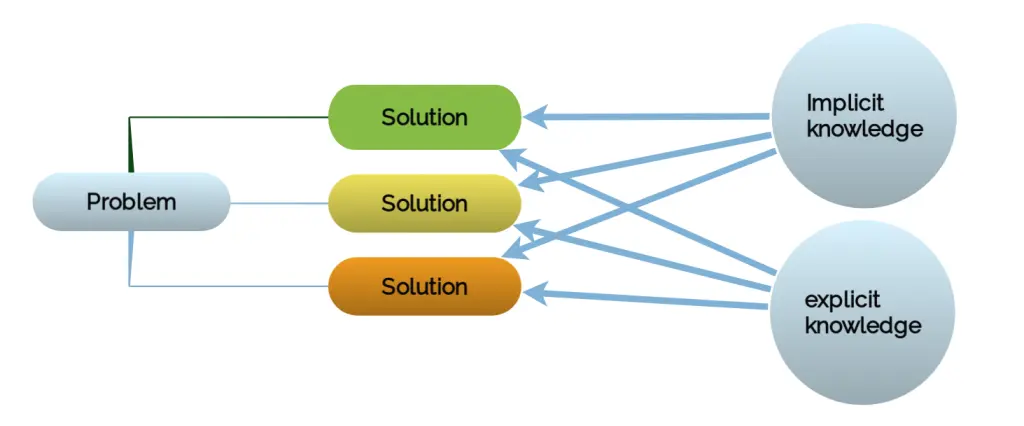
Explicit knowledge: Knowledge which is documented and accessible.
Implicit knowledge: Knowledge we assume to be well known, self evident or common sense. Like the fact that a company only builds a certain type of product. A candy manufacturer only builds candy, but not chocolate and as this is well known in the factory, there is no need to additionally mention it. At least not for humans.
Artificial Intelligence does not know about implicit knowledge and therefore can’t consider it when weighing propabilities. So the aim is to get rid of all implicit knowledge and convert it into explicit one.
As an example, we address the following challenge:
Develop a bus
The statement „Develop a bus“ itself already uses some implicit knowledge- that the company addressing the problem only produces buses and no cars, planes or ships. It therefore narrows the solution space (and by doing this, the problem space as well) and furtherly implies, that any solution has 6-8 wheels, a steering wheel and an engine (using the implicit knowledge of what a bus comprises).
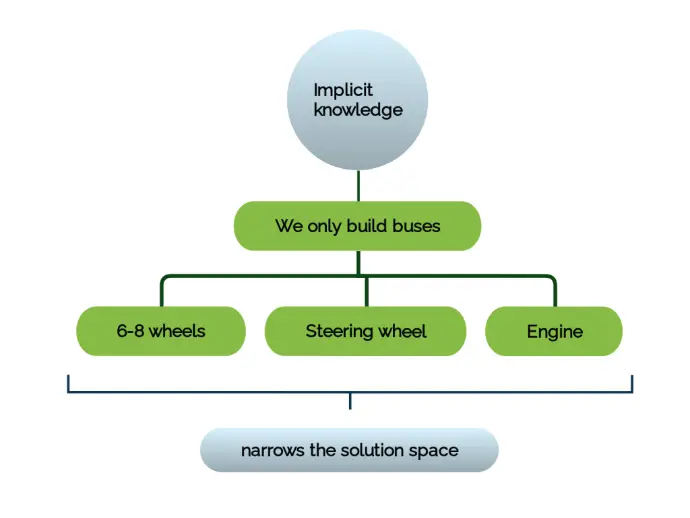
However, we still have several possible solutions available – large buses, smaller ones, expensive, etc. so we are narrowing the space furtherly by adding more requirements for costs and size:
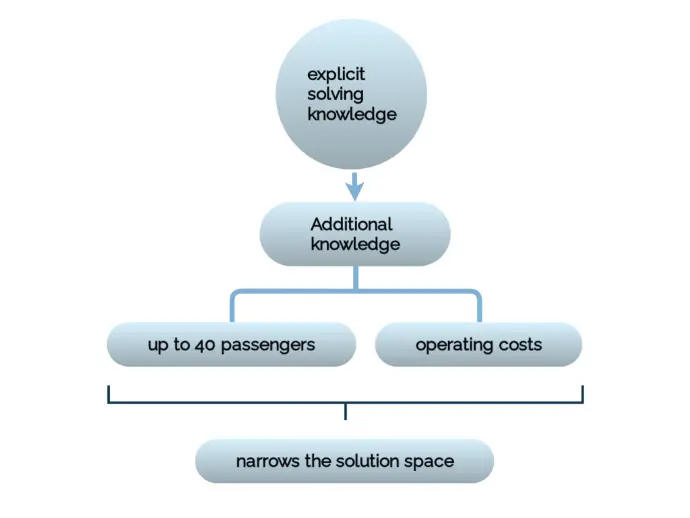
So in the end, the combination of explicit and implicit knowledge has solved the problem of the „bus development problem“ leading to a convenient solution.
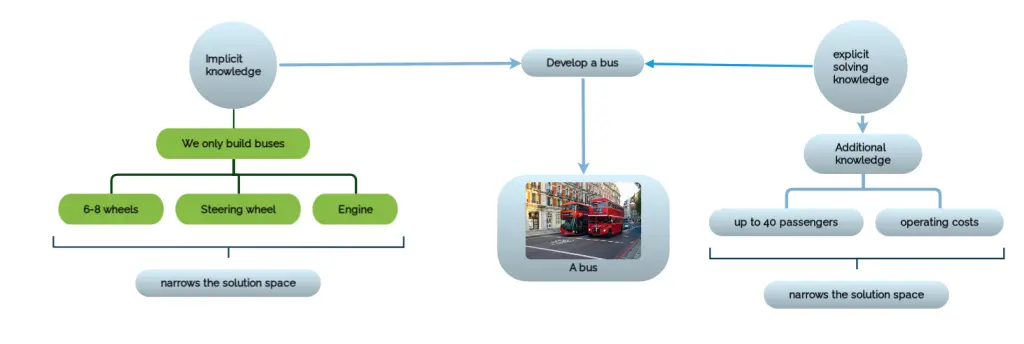
Addressing implicit knowledge
Implicit knowledge has several issues- one of them being a constant source for misunderstandings in the product development life cycle. It leads to definition gaps and will prevent the automation of solution elaboration. The more information available, the narrower the final solution space will be.
Therefore we rethink the example from above and restart from scratch by giving a new definition of the problem:
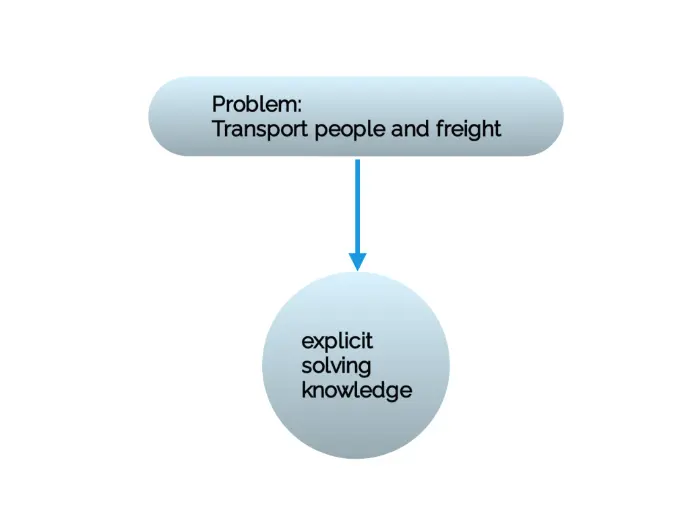
The „Transport people and freight“ challenge is the same as above. It simply does not use any implicit knowledge of the final solution and keeps the potential innovation space wide open:
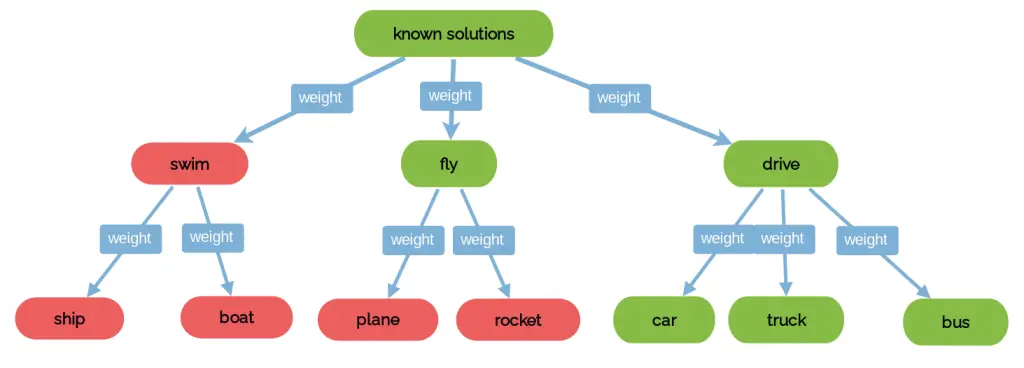
Solving the transportation issue can be accomplished by including all knowledge of already existing solutions: Swimming, flying driving – boats, ships, planes, rockets, cars, trucks and buses.
Now, to eliminate the unwanted solution options, the human brain considers more information by providing more side information as additional knowledge:
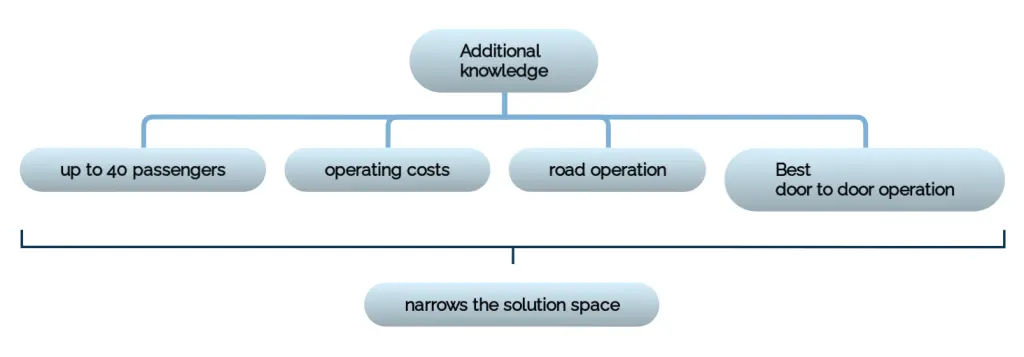
Note the „road operation“ requirement as it eliminates at least swimming and the „best door to door“ capabilities, which mostly eliminates flying unless we come up with flying taxis and buses capable of doing so. Which demonstrates the volatility of the solution space, if additional knowledge is available – eg. flying cars that can provide door to door operation.
In the end, after considering all available knowledge, the possible solution can be defined with a 100% probability to be best fitting.
And how about innovation?
Innovation comes into the game with the availability of more potential solutions and explicit knowledge changing to the better side of life.
Eg. when the operation costs of one path are lowered to the extreme
by new technology being made available, it might make another solution
path feasible.If the AI is trained to know about it.
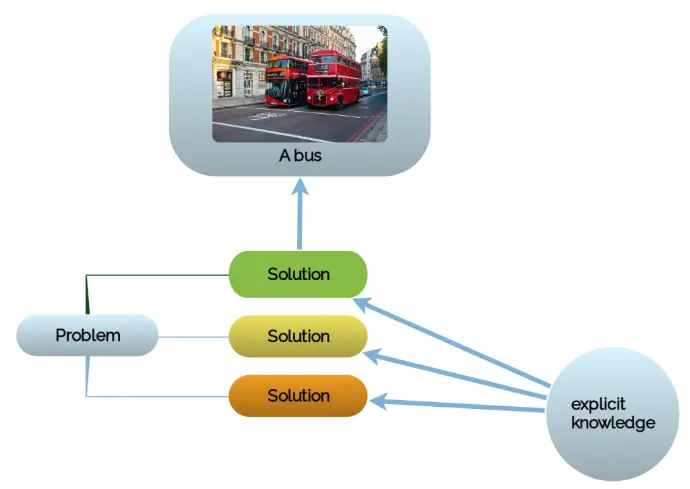
The AI challenge
Aiming at a scenario which automatically enables AI to solve our product engineering challenges, it is crucial to have all information explicitly accessible to the AI to enable it to come up with high probability results.
As AI is struggling with creativity, it does not evolve new ideas of its own. It can only rely on existing information and dependencies. However, accessing a broader pool of external information, it can point to options which had not previously been discovered.
After learning about the existing solutions, it is capable of relating problems to these solutions and bring everything together. With the approach from above, telling the AI to create a bus specification is easy and enables it to create the appropriate artifacts by narrowing the parameters down to the necessary:
"Create a specification for a bus" will lead to several options while "create specification for a bus to transport 40 people across the Alps" gives the AI, as well as a human, a lot of (implicit) information about the engine power and gears necessary, because we learned how to relate (or calculate) this information towards a solution. This is what we call "Engineering".
In fact, the approach the AI and a human are taking to solve product engineering issues are quite similar- applying knowledge to find solutions and narrowing down the options. While humans can rely on experience, an AI has to be trained and kept updated with knowledge. It doesn´t really know what works and what is not feasible – unless it is given this information.
Human limitations? AI to the rescue
However the increasing complexity and information involved today complicates the process of keeping pace with the development and manage all this complexity.
And as soon as it is made available to the AI, it will be considered for further operation. By integrating external sources of knowledge (eg. data sheets and specifications from suppliers), better decisions can be made leading to better solutions.
Collecting linear information is an easy task for it- „Create a spec
for a medical class A device for the American market“ is easy, as it
means to collect and merge all (relevant) requirements from eg. IEC
60601 plus the typical requirements for devices in the US according to
FDA regulations and electrical standards (socket connectors, power
supply, Labels, etc.).
This is mostly static information. And,
frankly, 80% of product requirements are static and not product
specific. Therefore, AI helps us here taking over boring redundant
tasks.
Catching the details – the specific 20%
To be capable of the other 20%, it needs to learn about product lines, products and variants and how functional components solve different problems. Which is an extensive learning curve. The more we dive down into the system levels, the more complex it gets.
On the other had, having mastered the curve brings an exciting potential for corporations on minimizing efforts as the AI holds all information about products, product lines, components and their relations in a way which makes extending existing solutions and finding best approaches easy while dramatically reducing complexity and fully keeping complexity.
The future of product engineering
Ai will enhance product engineering in the future by a few factors:
- Relief humans from redundant tasks when creating specifications
- Maintain the increasing system complexitiy and traceability
- Relate information to find new solution approaches
- Simulate different options by playing with knowledge parameters
- Enable for better strategic decision making
- Analyze corporate data beyond the problem-solution realm
- Better results and more efficiency, eg. when estimating. through enhancing the data with more attributes, like costs, risks, etc.
- and more
Building the corporate information pool requires solid existing data which eliminates implicit knowledge. In fact it doesn’t even need to be structured appropriately, if only correct traceability can be ensured.
It’s all about the quality of the data. As usual. And the possibilities are endless if this quality is ensured.